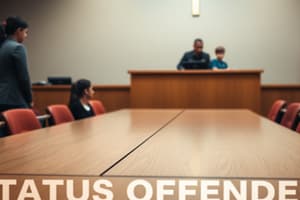Podcast
Questions and Answers
Quel est le principe fondamental qui guide la logique éducative appliquée aux mineurs délinquants?
Quel est le principe fondamental qui guide la logique éducative appliquée aux mineurs délinquants?
- La sanction immédiate pour dissuader de futurs délits.
- La priorité à l'éducation avant la sanction, privilégiant la prévention et la correction des comportements. (correct)
- L'application stricte de la loi, sans considération de l'âge du délinquant.
- L'isolement du mineur délinquant pour protéger la société.
Comment la justice pour mineurs adapte-t-elle les peines d'emprisonnement?
Comment la justice pour mineurs adapte-t-elle les peines d'emprisonnement?
- Les peines sont toujours identiques à celles des majeurs pour les mêmes infractions.
- Les peines sont systématiquement doublées pour avoir un effet dissuasif.
- Les mineurs ne sont jamais condamnés à de la prison.
- Une peine de trois ans peut être réduite de moitié, ce qui reste une sanction non négligeable. (correct)
Comment a évolué la nature de la délinquance des mineurs au fil du temps?
Comment a évolué la nature de la délinquance des mineurs au fil du temps?
- Les délits sont de moins en moins fréquents.
- Elle s'est déplacée des violences physiques vers les délits à caractère socio-économique.
- Elle est de plus en plus marquée par une augmentation des violences physiques. (correct)
- Elle est restée inchangée, se concentrant toujours sur les délits matériels.
Quel est l'objectif principal des réformes concernant la justice des mineurs mises en avant par les ministres de la Justice?
Quel est l'objectif principal des réformes concernant la justice des mineurs mises en avant par les ministres de la Justice?
Comment la vulnérabilité influence-t-elle l'attention accordée aux majeurs dans le droit pénal?
Comment la vulnérabilité influence-t-elle l'attention accordée aux majeurs dans le droit pénal?
Quel est le rôle de la criminalistique dans le processus judiciaire?
Quel est le rôle de la criminalistique dans le processus judiciaire?
Quelle est l'une des principales difficultés rencontrées dans l'approche criminologique?
Quelle est l'une des principales difficultés rencontrées dans l'approche criminologique?
Comment la criminologie peut-elle être structurée?
Comment la criminologie peut-elle être structurée?
Comment les tatouages étaient-ils interprétés à l'époque de Lombroso en lien avec la criminalité?
Comment les tatouages étaient-ils interprétés à l'époque de Lombroso en lien avec la criminalité?
Quelle est la perception actuelle des tatouages par rapport à leur association historique avec la criminalité?
Quelle est la perception actuelle des tatouages par rapport à leur association historique avec la criminalité?
Flashcards
Logique éducative pour mineurs
Logique éducative pour mineurs
Éduquer avant de sanctionner, avec une priorité donnée à la prévention et à la correction des comportements par des mesures éducatives.
Objectif des réformes de la justice des mineurs
Objectif des réformes de la justice des mineurs
Les réformes de la justice des mineurs visent à adapter la justice aux évolutions sociétales et aux préoccupations liées à la délinquance juvénile.
Rôle de la criminalistique
Rôle de la criminalistique
La collection et l'analyse des preuves nécessaires à l'établissement de la vérité.
Définition de la criminologie
Définition de la criminologie
Signup and view all the flashcards
Axes principaux de la criminologie
Axes principaux de la criminologie
Signup and view all the flashcards
Fonction du fichier Gaspard NG
Fonction du fichier Gaspard NG
Signup and view all the flashcards
Pourquoi les criminels restent un sujet d'étude
Pourquoi les criminels restent un sujet d'étude
Signup and view all the flashcards
Study Notes
- Criminology CM 1
Juvenile Justice Philosophy
- The educational approach for minors prioritizes education over sanctions, focusing on prevention through corrective measures.
- Repression is reserved as a last resort when education fails.
- The management of minors involves three key areas: prevention, education, and, if necessary, repression.
Sentencing Minors (16+)
- A magistrate can impose an adult sentence on minors over 16, considering the offense's circumstances and the minor's personality.
- Strict conditions surround this decision, emphasizing its exceptional nature.
Perceptions of Punishment
- The idea minors "fear nothing" is incorrect.
- A three-year sentence for a minor may be halved, resulting in an 18-month sentence, considered a serious penalty.
Evolution of Juvenile Delinquency
- Offenses have shifted from material crimes linked to socio-economic factors to physical violence.
- There is growing concern about gangs, including all-female groups, in cities like Paris, Lyon, and Marseille.
Juvenile Justice Reforms
- Justice ministers regularly promote reforms to address juvenile delinquents.
- The 2019 reform, implemented in September 2021, aims to align juvenile justice with societal changes and concerns about juvenile delinquency.
Protecting Vulnerable Adults
- Vulnerable adults receive special consideration in criminal law, due to factors like age, physical or mental disabilities, or precarious social situations (especially for foreigners).
- Specific groups, such as the elderly, are prone to certain crimes like scams, while individuals with disabilities are vulnerable to exploitation.
Forensic Science Focus
- The primary goal of forensic science is to gather evidence that identifies offenders.
- This discipline uses a structured approach to reveal those responsible for criminal acts and study their treatment for trial.
- Forensic science is essential to the judicial process, as it ensures the collection and analysis of necessary evidence.
Criminology Defined
- Criminology is a discipline that uses various perspectives to study crime, criminals, and related phenomena.
- Due to the nature of criminology, it involves a multidisciplinary approach.
- Analyzing offenses like rape involves legal, procedural, psychological, sociological, and victimological perspectives.
- Each field enriches the analysis by providing added insights.
Challenges in Criminology
- A key difficulty lies in the multitude of viewpoints.
- Conflicting interpretations of concepts can emerge across disciplines.
- "Sexual assault" can include distinct legal classifications.
- Studying criminal events with various methods makes the work challenging.
Structuring Criminology
- Criminology is divided by the study of either the criminal act itself or the person who committed it, the criminal.
- There is no universally accepted definition of criminology, though definitions vary among researchers and schools of thought.
Focus on Victims
- Victimology focuses on crime victims.
- It helps to comprehend the suffering of victims and gain insight into criminals.
- Victimology is seen by some as a sub-discipline within criminology.
- Medicine helps both victims and criminals based on the study's goals.
Criminality Over Time
- Criminology emerged in the 19th century, unlike sub-disciplines such as victimology, which appeared in the 1950s, and progressed in the 1980s.
The Italian School
- Modern criminology started with the Italian School, especially Cesare Lombroso, Raffaele Garofalo, and Enrico Ferri.
- These pioneers, mainly doctors, based their criminological views on medicine.
- The medical influences impacted early legal ideas in criminology.
- Cesare Lombroso is well-known but controversial among criminologists.
- Some call his work "scientific deception".
- Although his "born criminal" thesis was interesting for its time because of the scientific approach, it is now disputed.
Lombroso's Theories
- Lombroso used a scientific method to build his theory.
- In his book "Criminal Man", he researched about 350 delinquent skulls and their physical traits.
- He looked for ties between a person's appearance and criminal tendencies, finding features like eye spacing or ear shapes.
- This search for a criminal "morphotype" fit into a biology of crime.
Questionable observations
- Many archaic and disputed observations can be explained by social contexts of the time.
- He linked tattoos and crime, since tattoos were tied to criminals, prostitutes, and sailors.
- Tattoos were a criminal ID, with meanings such as: spider web meant time in prison, a watch with no hands being time passing, empty tear dropping meaning attempted murder, and a filled tear drop meaning an act of murder.
- Today, tattoos do not have the same meaning.
The Evolution of Tattoos
- The meaning of tattoos has evolved through the years.
- What used to be seen as a criminal marker is now common among all social classes.
- Observations show attempts to explain crime with biology and society, although these theories no longer apply.
The Use of Tattoos in Identifying Criminals
- Tattoos used to help pinpoint criminals.
- As they realized marking themselves tattoos could make them easier to find, criminals avoided it.
- This steered criticism toward ideas that link tattoos and crime.
- Scientist Edmond Locard wrote tattoo and crime links were wrong, because a tattooed person was not an offender.
Biometric Data
- Tattoos remain an element of identification.
- During arrests or detentions, authorities gather biometrics like fingerprints, genetics, and body traits, including tattoos.
- The automatic reporting system Gaspard NG is used for this.
- The stored information can be used to match other reports.
Perceptions of criminals
- Thoughts about criminals are often wrong.
- We can be mistaken about who can be a criminal, based on media portrayals.
- On the other hand, we relate to victims easier, since we know we can be victims.
- Those who are women connect with victims of street stalking, because they have experienced or fear it.
Fascination with Criminals
- Criminals draw interest, even though they are condemned.
- The dual sentiment between moral rejection and curiosity explains why criminals stay an area of analysis and interest.
Studying That Suits You
Use AI to generate personalized quizzes and flashcards to suit your learning preferences.




